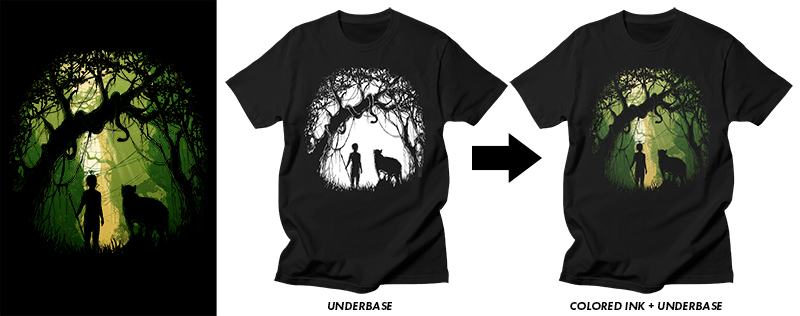Design 101: Optimizing Your File for Print
Print Method
Images printed through Threadless.com and Artist Shops are printed on-demand. This is a printing method where a digital printer is used to print a design directly onto a garment or canvas using inkjet technology with direct-to-garment (DTG) or sublimation printing. Picture a futuristic inkjet printer the size of your bathroom that costs more than a house! It's like a giant inkjet printer, but using blank garments instead of paper- that’s essentially how on-demand printing works.
File Requirements
Because all products are created on-demand we have some important file requirements that you should keep in mind when setting up your images.
- Size: Images should be 4200x4800 pixels, at 300dpi. The DPI refers to dots per inch or pixels per inch. It is a unit used to measure the overall resolution of an image and the higher the DPI or PPI is the sharper an image can be. 4200x4800 pixels at 300dpi translates to 14x16 inches, which covers the entirety of the printable area on a garment. Your typical clothing file setup would look something like this:

Our templates are sized to our requirements and can be found here .
- Color Mode: Because files will be printed through what is essentially a giant printer, all images should be in the RGB color mode. RGB refers to the color mode of the image. Unlike traditional CMYK printing, which uses the Cyan Magenta, Yellow, and Black inks to create a variety of colors, RGB mode uses only Red, Green, and Blue inks to print the designs on products. For better color accuracy and reproduction we suggest your image be set up in the RGB color mode.

- Transparencies: DTG printing allows for the printing of transparent inks and colors at varying opacities. However, it is important to keep in mind that all designs printed on colored shirts will have a white layer printed underneath. This layer is called an underbase and it is used to ensure the vibrancy of inks on dark or colored backgrounds. Think of it as the printer turning all of the colors of your design white so that it could print colors on top of it.
Here’s an easy visual of the process:
- While this is great for making colors pop, it also means that any ink that is transparent or not fully opaque will show the white base underneath and may result in an effect being different than what was intended. As you can see in the image below, a magenta at 30% opacity looks a bit different with an underbase than it would without.

- Placement: The sizing and placement of your design within the image will determine the placement and size of the artwork on the printed product. For ideal placement, we recommend that your design is placed high on the 4200x4800 PNG.
 Read more about design placement in our placement guide.
Read more about design placement in our placement guide.
- File Type: The last thing to make sure of is that you're uploading the correct file type for the product. PNGs are recommended for clothing because they allow for transparent backgrounds and let your design mesh with the background better. JPGs are recommended for Home goods, accessories, and other products because they allow the design to cover the entire product. For more information, check out our guide to design size and placement for non-apparel.
For a more in-depth look at DTG printing and some more things to watch out for, check out our full optimization guide.

 Read more about design placement in our
Read more about design placement in our